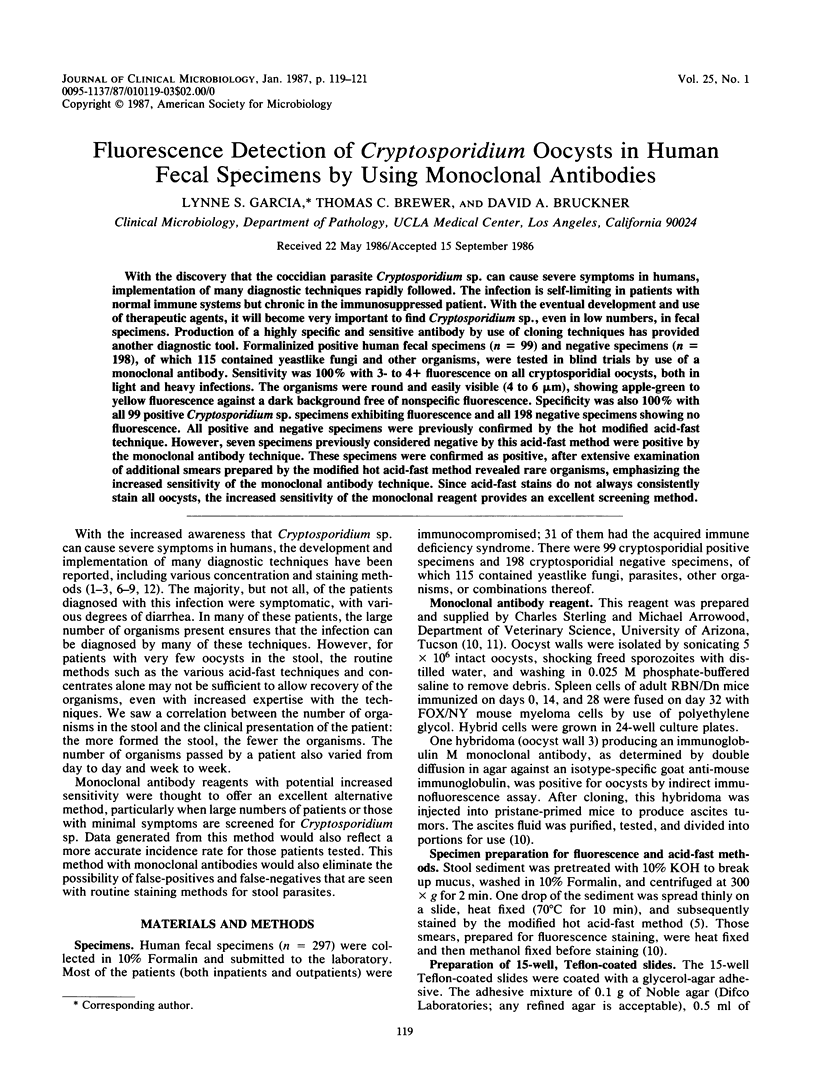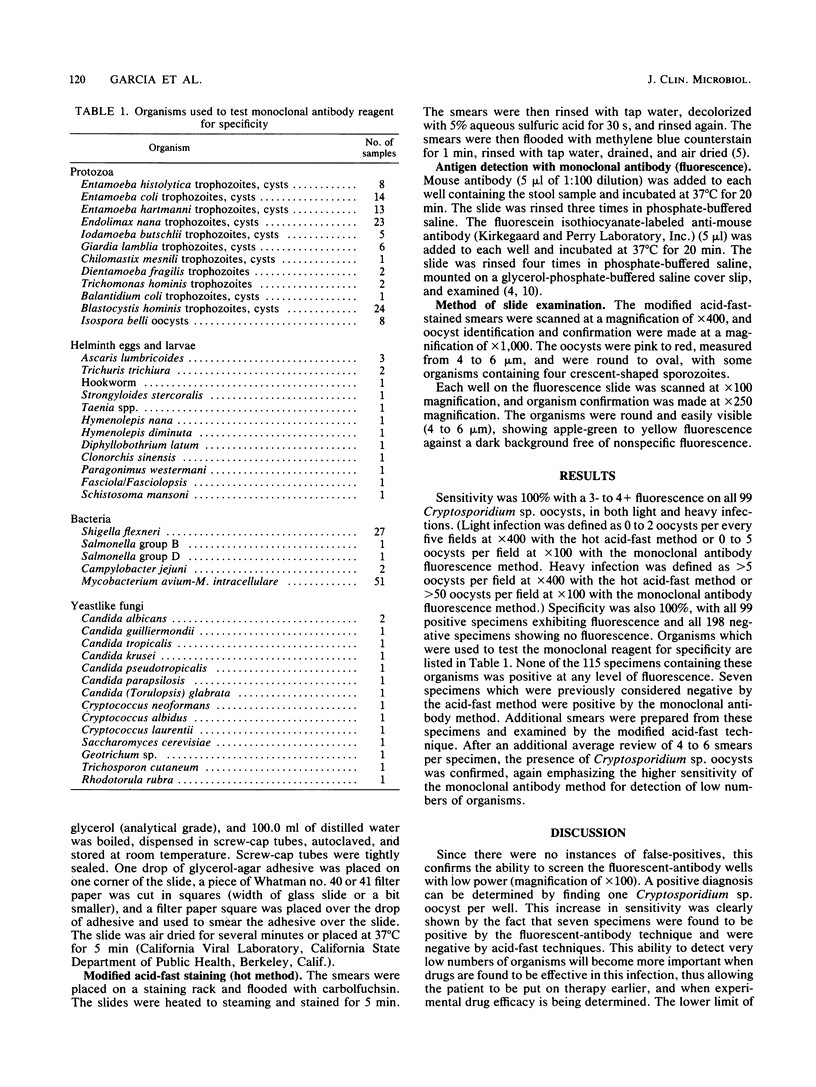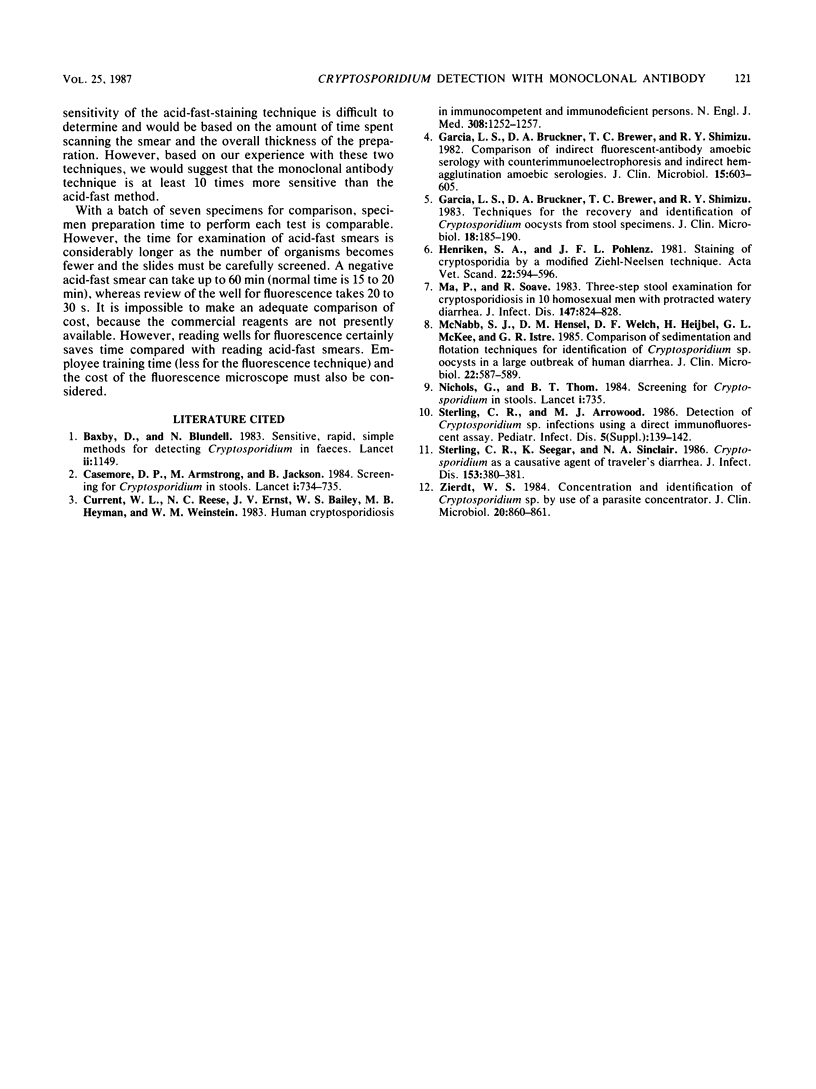Abstract
With the discovery that the coccidian parasite Cryptosporidium sp. can cause severe symptoms in humans, implementation of many diagnostic techniques rapidly followed. The infection is self-limiting in patients with normal immune systems but chronic in the immunosuppressed patient. With the eventual development and use of therapeutic agents, it will become very important to find Cryptosporidium sp., even in low numbers, in fecal specimens. Production of a highly specific and sensitive antibody by use of cloning techniques has provided another diagnostic tool. Formalinized positive human fecal specimens (n = 99) and negative specimens (n = 198), of which 115 contained yeastlike fungi and other organisms, were tested in blind trials by use of a monoclonal antibody. Sensitivity was 100% with 3- to 4+ fluorescence on all cryptosporidial oocysts, both in light and heavy infections. The organisms were round and easily visible (4 to 6 micron), showing apple-green to yellow fluorescence against a dark background free of nonspecific fluorescence. Specificity was also 100% with all 99 positive Cryptosporidium sp. specimens exhibiting fluorescence and all 198 negative specimens showing no fluorescence. All positive and negative specimens were previously confirmed by the hot modified acid-fast technique. However, seven specimens previously considered negative by this acid-fast method were positive by the monoclonal antibody technique. These specimens were confirmed as positive, after extensive examination of additional smears prepared by the modified hot acid-fast method revealed rare organisms, emphasizing the increased sensitivity of the monoclonal antibody technique. Since acid-fast stains do not always consistently stain all oocysts, the increased sensitivity of the monoclonal reagent provides an excellent screening method.
Full text
PDF


Selected References
These references are in PubMed. This may not be the complete list of references from this article.
- Baxby D., Blundell N. Sensitive, rapid, simple methods for detecting Crysporidium in faeces. Lancet. 1983 Nov 12;2(8359):1149–1149. doi: 10.1016/s0140-6736(83)90669-4. [DOI] [PubMed] [Google Scholar]
- Current W. L., Reese N. C., Ernst J. V., Bailey W. S., Heyman M. B., Weinstein W. M. Human cryptosporidiosis in immunocompetent and immunodeficient persons. Studies of an outbreak and experimental transmission. N Engl J Med. 1983 May 26;308(21):1252–1257. doi: 10.1056/NEJM198305263082102. [DOI] [PubMed] [Google Scholar]
- Garcia L. S., Bruckner D. A., Brewer T. C., Shimizu R. Y. Comparison of indirect fluorescent-antibody amoebic serology with counterimmunoelectrophoresis and indirect hemagglutination amoebic serologies. J Clin Microbiol. 1982 Apr;15(4):603–605. doi: 10.1128/jcm.15.4.603-605.1982. [DOI] [PMC free article] [PubMed] [Google Scholar]
- Garcia L. S., Bruckner D. A., Brewer T. C., Shimizu R. Y. Techniques for the recovery and identification of Cryptosporidium oocysts from stool specimens. J Clin Microbiol. 1983 Jul;18(1):185–190. doi: 10.1128/jcm.18.1.185-190.1983. [DOI] [PMC free article] [PubMed] [Google Scholar]
- Henriksen S. A., Pohlenz J. F. Staining of cryptosporidia by a modified Ziehl-Neelsen technique. Acta Vet Scand. 1981;22(3-4):594–596. doi: 10.1186/BF03548684. [DOI] [PMC free article] [PubMed] [Google Scholar]
- Lo Cascio V., Adami S., Galvanini G., Cominacini L., Scuro L. A. The time course of a hypercalcaemic crisis in acute primary hyperparathyroidism. Lancet. 1984 Mar 31;1(8379):735–736. doi: 10.1016/s0140-6736(84)92246-3. [DOI] [PubMed] [Google Scholar]
- Ma P., Soave R. Three-step stool examination for cryptosporidiosis in 10 homosexual men with protracted watery diarrhea. J Infect Dis. 1983 May;147(5):824–828. doi: 10.1093/infdis/147.5.824. [DOI] [PubMed] [Google Scholar]
- McNabb S. J., Hensel D. M., Welch D. F., Heijbel H., McKee G. L., Istre G. R. Comparison of sedimentation and flotation techniques for identification of Cryptosporidium sp. oocysts in a large outbreak of human diarrhea. J Clin Microbiol. 1985 Oct;22(4):587–589. doi: 10.1128/jcm.22.4.587-589.1985. [DOI] [PMC free article] [PubMed] [Google Scholar]
- Sterling C. R., Seegar K., Sinclair N. A. Cryptosporidium as a causative agent of traveler's diarrhea. J Infect Dis. 1986 Feb;153(2):380–381. doi: 10.1093/infdis/153.2.380. [DOI] [PubMed] [Google Scholar]
- Zierdt W. S. Concentration and identification of Cryptosporidium sp. by use of a parasite concentrator. J Clin Microbiol. 1984 Nov;20(5):860–861. doi: 10.1128/jcm.20.5.860-861.1984. [DOI] [PMC free article] [PubMed] [Google Scholar]


